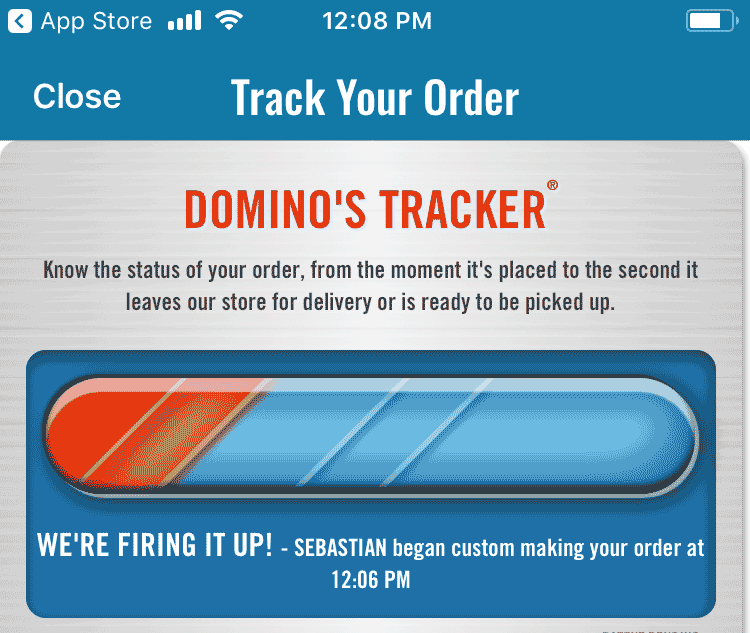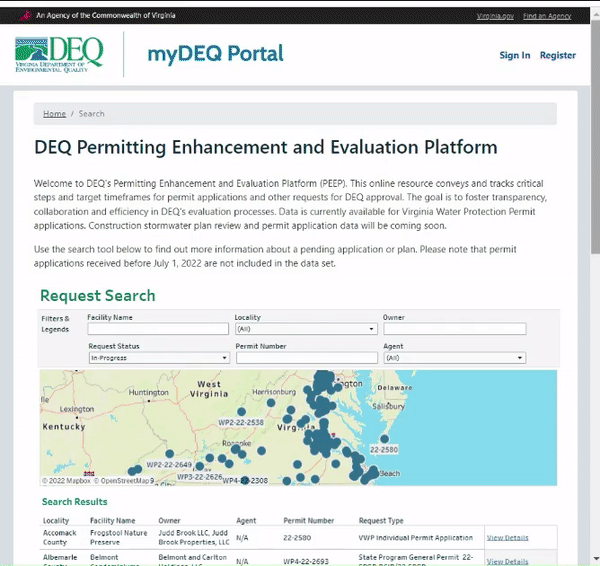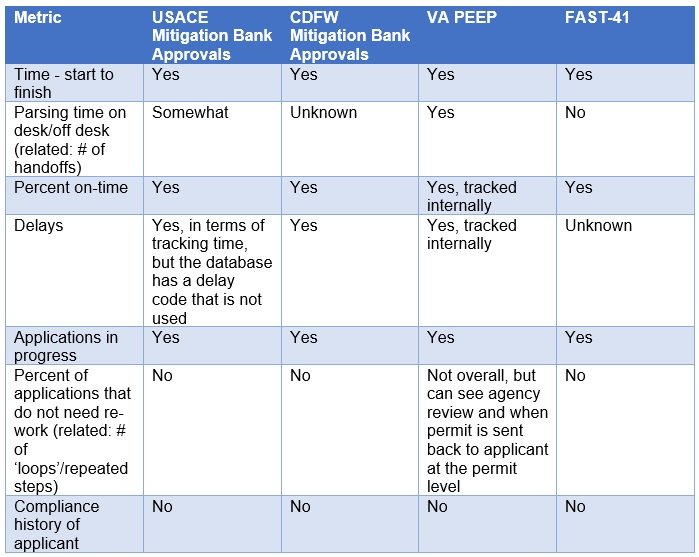If You Can Track a Pizza, You Can Track a Permit
Friday night is pizza night in my household, and Domino’s is a staple in our rotation. They have a great pizza tracker app that gives you a sense of the steps in the process and importantly, when to leave the house to pick up that pizza right when it’s fresh out of the oven!
Wouldn’t it be nice to apply this pizza tracker idea to other processes, like a permit going through regulatory approval?
I’ve spent over 100 hours analyzing US Army Corps of Engineering (USACE) data over the last couple months, especially looking at the approval timeframe of mitigation bank approvals (report forthcoming). The experience sometimes makes me shake my head and wonder: If you can track a pizza, why can’t you track a permit?
It turns out you can, in Virginia. Several other permit tracking/streamlining efforts in the US have made advances, but miss out in documenting deadlines, tracking progress, providing transparency, and utilizing this technology to diagnose and improve the permitting process (more on this later).
Virginia’s Permitting Enhancement and Evaluation Platform (PEEP)
Mike Rolband, Director of Virginia’s Department of Environmental Quality (DEQ), knows permitting. DEQ had approximately 20,000 outstanding permits in 2021 and approved over 3,300 permits that year. In his former role as founder of a natural and cultural resources consulting firm he’s also been in the applicant’s shoes - he says his record for number of approvals needed for one project is 14, so he can understand the desire for streamlining restoration permitting. Rolband has said his “number-one task is to make DEQ processes more clear and hopefully by clarifying things we can expedite the permitting process.” The Permitting Evaluation and Enhancement Program (PEEP) does this by bringing together every DEQ permit type into one system that tracks and provides transparency of a permit and its stage in the approval process (see GIF below). PEEP is a publicly-accessible online platform where anyone can search and find details about a permit and where it is in the approval process, including when it was received, whose desk it’s on now (including coordination with external agencies like USACE when applicable), and how much time the steps in the process are taking vs. target timeframes. As the website says, the goal of PEEP is “to foster transparency, collaboration and efficiency in DEQ's evaluation processes.”
“We’re going to track where it [a permit] is, because right now it’s a black box for everybody, for the public and the permittee… You apply for a permit and you don’t know what happened to it. And often it gets stuck somewhere. So I want to have a public online platform where anybody can find out where the permit is in the process”
The PEEP platform just went "live" (after beta testing internally for 4 months) on December 1, 2022 with its pilot program for the Virginia Water Protection Permits (i.e. "permitted impacts to wetlands and stream"). See the official press release from the Governor’s office here. Additional functionality for all of DEQs 12 major permit programs will be rolling out publicly throughout 2023. Releases of particular interest to the restoration industry are functionality for wetland and stream mitigation banking (Q2 2023), and nutrient mitigation banking (Q3 or Q4 2023). VA DEQ has been coordinating with the Norfolk District of the USACE in the PEEP development process to ensure there is no duplication of effort on tracking permit target time and steps in the process.
Here’s what it looks like, from the opening screen where you can search permits, to the permit details that include target timeframes and coordination with external agencies.
Note in the GIF how time with the applicant is tracked in yellow. This is important to track, as without it, it would be impossible to know whether the agency or the applicant was holding up the approval process. Tracking coordination with other agencies (e.g., with other Virginia agencies, or federal agencies like USACE or the US Fish and Wildlife Service) is also important as ‘complex’ projects requiring multiple permits have been cited as a factor in permit timelines (Kihslinger et al., 2020).
PEEP in action. Source: VA DEQ.
Other Initiatives are Setting Deadlines Too, but Lack Aspects of Tracking and Transparency
If someone asks me in an email to do something without giving me a deadline, it goes to the bottom of my to-do list. I would imagine that’s even more the case with understaffed regulatory agencies. Besides PEEP, I know of three other efforts that set and track permitting deadlines relevant to restoration projects.*
The USACE and CA Department of Fish and Wildlife (CDFW) both track mitigation bank approval timelines. The Federal Permitting Improvement Council (FPISC) tracks over 1,000 large projects (e.g., >$200 million) that meet certain criteria in the FAST-41 initiative. Virginia’s tool in this early stage is already tracking 169 Water Protection Permits. All initiatives are codified in regulation (2008 Rule for USACE), or legislation (SB 1148 for CDFW, and the Fixing America’s Surface Transportation Act for FAST-41). In the Permitting Council data, 20 projects are restoration or resilience projects.
The USACE tracks overall time as well as interim time intervals in its ORM database, but the data is only available through a FOIA request - not very transparent for public data. CDFW tracks similar time intervals as USACE, and provides some transparency due to state law that requires an annual report to the legislature. Like USACE, CDFW data is only available through a FOIA request. FAST-41 sets a target end date for the full project, along with target dates for individual permits. Permitting activity for FAST-41 projects is tracked in a nicely designed online dashboard. Automated reports, visualizations, and data downloads, an API, and a data dictionary are available for FAST-21 projects. That being said, it seems like data isn’t updated regularly, leaving some data sets incomplete. In my experience, some links to visualization give an error when accessed and a notice on another part of the website indicates that “no new quarterly accountability scorecards will be published on the Permitting Dashboard.” Other visualizations accessed through the full dataset link seem to work, although require some effort to understand due to the way data is stored (e.g., one project may be recorded 8 times - one row for each permit). Despite the challenges, FAST-41 has the most robust data accessibility I have seen for federal permitting.
With regards to performance on meeting deadlines, USACE’s process is 1.6x longer than the 225 days required by law (EPIC report forthcoming, based on USACE data), and CDFW misses deadlines 72% of the time (their maximum timeframe is 270 days). It is unclear how many of the FAST-41 projects met their deadlines. The not-updated-since Q4 2020 scorecard only appear to use data from 50 permits (out of the 1,000+ we found through the data download). Of that sample, the scorecard indicates that 47 permits had target timetables. The only permit timetable tracked was completion of Environmental Impact Statements - and only for 9 of those permits (8 of which were behind schedule - either for reasons outside or inside the federal government). It would require a moderate amount of effort to analyze whether FAST-41 project deadlines were met from the raw data.
How PEEP Provides Tracking and Transparency
Like the USACE and CDFW, PEEP does not provide a data download and would require a FOIA request to access it. However, unlike the initiatives above, PEEP has an overall target timeframe, as well as targets for interim steps in the process. PEEP uniquely tracks time on the agency’s desk, as well as time that the applicant is taking to respond to agency requests (see below). I’d call this a best management practice (BMP) for permit tracking. Delays may be on the agency’s side, the applicant’s side, or both, but it’s obscured if time-in/time-out is not tracked. Finally, PEEP is unique in that the initiative was championed by state government leadership, rather than external stakeholders lobbying for it.
An example of target timeframes provided in PEEP. This particular box is showing the applicant’s responsibility for one of the steps in permitting. The applicant’s target timeframe was 15 days, but they completed the step in 55 days. Source: VA DEQ.
I’d like to point out that tracking is not just about finding problems - it’s about adaptive management. If all you have are anecdotes or opinions like “It’s too slow!,” then ideas for fixing the problem are really only informed guesses. Any attempted fix will be arbitrary and potentially ineffectual. If you have data, changes are informed. And the more nuanced your data is, the more you can try to understand what parts of the process are gumming up.
For inspiration on more nuanced metrics, we can look to a 2018 Federal workgroup framework of metrics to evaluate the effectiveness of permitting. A selection of metrics proposed, along with whether these are tracked by the programs highlighted in this blog, is noted below. Note that poor “compliance history of the applicant” has been cited in the literature as a factor slowing permitting timeframes, and conversely, prior successful permits speeds timeframes (Ulibarri and Tao, 2019; Kihslinger et al., 2020).
Technology Can Streamline Processing for Regulatory Staff
Streamlining technology doesn’t have to be fancy - it can be as simple as adopting project management principles, which is something the National Ecological Business Association (NEBA) has proposed as a way to help regulatory staff save time and speed approval timelines. PEEP shines in providing automation and project management of permits. PEEP provides an internal staff task list of the permits they are responsible for, and creates automatic emails for applicants, external agencies, and internal staff (see below). The system also creates dashboards for internal staff (and supervisors) and external agencies involved in permit reviews. Personally, I think this is brilliant.
Automatic emails provided by PEEP. Source: Rolband, 2022, presentation to the Ecological Restoration Business Association.
PEEP can also create automatic reports for management to track the average timeline and range for different permits. This is that adaptive management piece at the high level - with the data tracked by PEEP, VA DEQ can look for efficiencies and focus changes where processes are slow.
I think PEEP is going to get very popular very soon. When other agencies and external stakeholders see the enormous benefits in setting target times, providing transparency, and gaining benefits of automated project management, there will be other agencies lining up to adopt a similar permitting platform.
And if agencies find challenges in adopting new technology, the findings from EPIC’s new report on Accelerating Technology Projects in Environmental Agencies could help.
One final note: I applaud the efforts of all the agencies we’ve reviewed to set timeframes for permitting and to track data to understand whether those targets are met. I would make one ask of all of them - to allow public downloads (or APIs) of the underlying data, as FAST-41 does. External stakeholders can be an agency’s partner in adaptive management - they can point out things overlooked, or champion additional budget when it’s clear that staffing levels are causing costly delays. Providing the data could also reduce FOIA requests and the staff time to fill those requests.
Pathways to Streamlined Permitting for Restoration Projects
EPIC is committed to researching and lifting up pathways to streamlined permitting for restoration projects. The reason we’re doing this is because slow permitting reduces the supply of in-advance wetland and species restoration needed to offset impacts from infrastructure projects, and there is a lot of infrastructure ($600 billion) being funded from the Infrastructure Investment and Jobs Act. That act also provides unprecedented levels of restoration funding ($9.8 billion) for things like dam removals, abandoned mine remediation, flood risk reduction & resilience. Slow permitting eats up the costs of restoration projects which means more money goes into permitting that could be used for restoration. We need funding for nature, not paperwork.
EPIC has been tracking permitting streamlining for over a year. Check out our earlier posts about state streamlining, recent streamlining efforts in California and Maryland, and an explainer on NWP 27 - a general permit that streamlines Clean Water Act wetland & stream permitting at the national level specifically for restoration activities.
The Restoration Economy Center, housed in the national nonprofit Environmental Policy Innovation Center (EPIC), aims to increase the scale and speed of high-quality, equitable restoration outcomes through policy change. Join our newsletter list to make sure you are notified when new reports are published.
*If you know of other permitting streamlining efforts relevant to restoration projects, please let us know (becca@policyinnovation.org).






